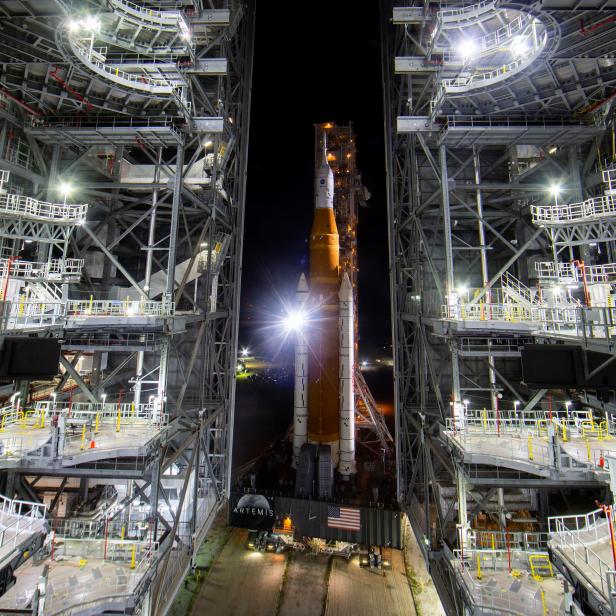
NASA/Joel Kowsky
Here Comes Artemis I (Rescheduled, again)

NASA's long-awaited Artemis 1 uncrewed moon mission and next generation of spacecraft has been delayed for a second time. The rocket was initially scheduled to launch on Aug. 29, 2022, at 8:33 AM ET, but was delayed due to an issue with the engine bleed. Watch Space Launch Live: Artemis-1 on Science Channel to see the moment of liftoff. (Launch Date Pending)
(Updated Sept 7, 11:00AM)
You see the rocket, pointed to the heavens, poised for takeoff. At first, all is silence. Then you see the flash of ignition, the billowing exhaust, and vapor rushing away. Finally, you hear it: a terrible seismic rumble threatening to engulf you.
For the briefest of moments, with the full range of the engines pushing the behemoth, it appears as if it won’t work. Try as we might, we cannot fight against the massive weight of the Earth pulling us down.
And then…liftoff. First sluggishly, then as the rocket gathers itself it leaps into the sky, heading to space.
There’s nothing quite like a launch, and there will be nothing on Earth like the upcoming launch of Artemis I, NASA’s attempt to bring humanity back to the Moon.
Watch Space Launch Live: Artemis-1 on Science Channel to see the moment of liftoff. (Launch Date Pending)
The Artemis I mission will be uncrewed, as it’s just a test of its two basic components. The first is the launch system itself, conveniently named the Space Launch System or SLS. While it may not look like it, the SLS is the successor to the Space Shuttle. For its first stage, the SLS uses four RS-25D rockets, which were all flown on the Shuttle. Combined, those engines generate 8,800,000 pounds of lift. That’s more than enough rocket-powered oomph to send a crew to the Moon, a feat we have not obtained since the Apollo missions of the 1970s.
Sitting atop the SLS is the Orion spacecraft, which in future flights will carry the crew to the Moon.
If all goes well, the entire mission will last 26 to 42 days. The first few days will be spent coasting to the Moon, followed by a few more days of using the Moon’s gravity to settle into an orbit. After another one to two weeks of orbit, the Orion spacecraft will set a course back home, where it will enter the Earth’s atmosphere and splash down in the Pacific Ocean.
The Artemis program has had a lot of difficulty getting off the ground (so to speak). It started its life over a decade ago from the remnants of the Constellation program, a previous attempt to develop a new generation of vehicles to send people to the Moon and Mars. And the costs have been enormous: NASA spent around $23 billion just to develop the SLS, let alone the other components and the funding necessary to run the missions themselves. The complexities of sourcing components from many states as required by Congress even earned the SLS a new name: the Senate Launch System.
NASA hopes to develop long-term partnerships with commercial companies so that these early visits to the Moon won’t be a repeat of the ’70s, with astronauts playing golf on the Lunar surface to the exasperation of weary and bored public. Instead, NASA hopes to use the Artemis program to sustain a permanent presence on the Moon and Mars.
In the end, it will be up to future generates to decide if the cost was worth it.









